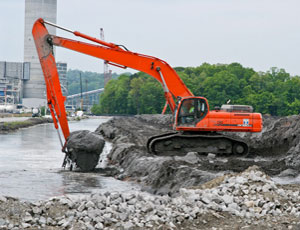A combination of factors, including a previously unknown layer of "slime," led to the Dec. 22, 2008, layer of coal ash sludge that overflowed its aging storage facility at a Tennessee Valley Authority power plant near Knoxville and contaminated hundreds of acres, according to a 1,400-page, three-foot-thick "root cause" analysis released June 25.

The analysis, conducted by Los Angeles-based AECOM Technology Corp., found that the angled geometry of the site, along with increased loads due to higher fill and the wet-placed loose ash, along with the weak slime foundation, all led to the failure, AECOM Senior Principal Engineer Bill Walton said. While the failure itself occurred within an hour, the dike had been on the verge of collapse for some time, he noted. The failure released 5.4 million cu yd of heavy metal-contaminated wet coal ash from a settling pond and flooded 300 acres of nearby land. Cleanup is expected to cost up to $825 million.
Walton refused to point the finger at any single action that TVA did to cause the failure or steps it could have taken to prevent it. While he resisted calling the factors a "perfect storm," he said their combination was "complex."
TVA had not previously discovered the weak slime foundation, which Walton explained as extremely small, round-particle silt on the bottom of the fly ash, which was very unstable, especially where the break occurred. It took AECOM more than two months of forensic investigation to find the slime, he said.
Because the slime acted like a liquid, it was not strong enough to hold up the dike. Eventually, the force pushing against the retaining dike exceeded the force of the dike holding it back, leading to a progressive failure of the structure.
Watson said that AECOM did not find any remnants of the dam that failed in its investigation.
A TVA spokesman said it has hired Stantec Inc., Edmonton, Alberta, to conduct investigations and analyze potentially similar risks at the public power-marketing agency's other coal ash ponds.

Post a comment to this article
Report Abusive Comment